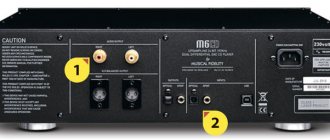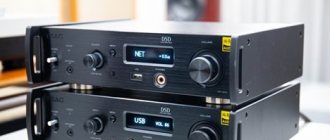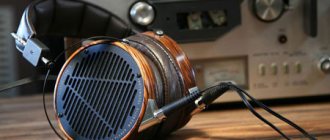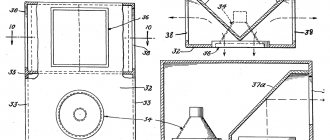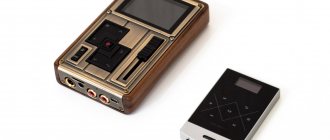Musical Fidelity M3Si – great sound and the highest detail of images!
The Musical Fidelity M3 Series line of high-quality audio equipment has been expanded with the M3Si integrated power amplifier. The new product has significantly increased the output power, increased the number of input terminals, and added a USB port.
The amplifier output power is 85 watts per channel with a load impedance of 8 ohms. A special power supply design combined with separate, high-capacity, high-power filter capacitors allowed engineers to minimize crosstalk.
The amplifier is made according to the classic dual mono configuration, ensuring identical characteristics of the left and right channels. And the use in the design of Musical Fidelity M3Si of exclusive components specially designed for surface mount technology (SMD Musical Fidelity) made it possible to reduce the length of printed conductors. This led to a reduction in linear capacitance and inductance, and also made it possible to expand the reproducible frequency band and dynamic range.
The level of nonlinear distortion of M3Si measured at a frequency of 1 kHz does not exceed 0.007%, and at a frequency of 10 kHz it is only 0.01%. This value of harmonic distortion, practically independent of the frequency of the input signal, can be considered a kind of record for Hi-Fi equipment. And it is this fact that best confirms the optimality of all circuit solutions.
According to independent experts, the sound of the Musical Fidelity M3Si has acquired an “elite character” and the highest musicality. The main advantages of the new product are an expanded stereo panorama combined with filigree accuracy and detail, as well as ideal channel separation and low noise level.
A special charm of the Musical Fidelity M3Si is given by its stylish compact body, made in classic shapes. Optimal switching equipment significantly expands the capabilities of the new product.
You can directly connect a vinyl player to the amplifier without an additional phono preamplifier, it is already built into the M3Si. Thanks to its high sensitivity, low noise level (less than 88 dB) and an extended frequency range up to 50 kHz, the amplifier will be an ideal partner for any audiophile turntable.
The frequency response of the built-in phono stage fully complies with the requirements of the RIAA standard (the frequency response unevenness does not exceed ± 0.5 dB in the frequency range from 20 Hz to 20 kHz). MM and MC cartridges are supported.
To work with digital audio data, the Musical Fidelity M3Si has an asynchronous USB port. With its help, you can play an audio stream recorded with a bit depth of 24 bits and a quantization frequency of 96 kHz. Low levels of jitter and digital noise allow you to get clear and detailed sound with a wide dynamic range using a digital audio file.
Well, to supply analog signals, as many as four stereo pairs are mounted on the patch panel.
The device is available in black and silver.
Peculiarities:
- High power output
- Low noise and distortion throughout the entire operating frequency band
- High quality, detailed and accurate sound
- Stylish and compact design
- Availability of an asynchronous USB port for working with digital audio data
- Supports MM/MC cartridges
- Four analog input ports
- Light weight
Specifications:
Amplifier
Output power - 85 W per channel into 8 ohms
Nonlinear distortion factor -
Signal to noise ratio - more than 98 dB
Reproducible frequency range - 10 Hz - 20 kHz (with frequency response unevenness from +0 to -0.1 dB)
Input ports
Four stereo input pairs - Line Level RCA / Phono
Asynchronous USB port - Type B female (supports 24-bit audio at 96 kHz)
Stereo pair for connecting MM/MC pickup
Characteristics of the input port for connecting the MM/MC pickup
Nominal sensitivity - 3mV (suitable for cartridges with a signal level of 1.5 mV or more, including MC type)
Signal to Noise Ratio: >70dB "X-weighted"
Input impedance – 50 kOhm
Frequency range – 20 Hz to 20 kHz (with frequency response unevenness ± 1 dB, meets the requirements of RIAA / IEC standards)
Weight and dimensions
Dimensions (WxHxD): 440 x 100 x 400 mm.
Weight (unpacked / packaged) - 9.2 kg / 13 kg.
Dark horses
Ratings
| + | clear, unified voice, excellent articulation, careful attention to detail, commendable genre versatility | — | limited power reserve, load sensitivity, ergonomic problems |
Design
95
Workmanship 90
Sounding 95
Ergonomics 85
Total 95
Conclusion:
An exclusively musical device, which, when selecting speaker systems that are adequate in terms of load and are not inferior to it in quality, will set a sound level that will be damn difficult to overcome without significantly higher costs. This will be a system for the soul and for a long time.
Let's start by assessing the functionality of the participants and their ease of use. Based on this criterion, the initial pessimistic forecasts, in general, were completely confirmed (except for the Cambridge Audio Azur 651A, which focuses specifically on the “interface” and receives a high score here). And in general, the ergonomics this time somehow went wrong; only two out of five models got information displays, and in both cases the thought flashed that it would be better not to have them. On the same Cambridge Audio device, the display, overloaded with large pale blue symbols and made in the style of cinema receivers, was very distracting and made me want to turn it off. And in Musica Int-200, the formally present arrow volume scale had minimal information content. With this Japanese guest, we actually had a number of funny situations that could have fatally affected the test results if we had followed the lead of the first, sharply negative impressions based on the assessment of appearance. In all my practice of listening to various equipment, I remember the only similar case where a component was so defiantly inconvenient to use (and seemed to be made with marked disregard for the minimum requirements of ergonomics) - the Silhouette SXCD CD player from the New Zealand company Perreaux. It also did not have a single signature on the body and, it seemed, was specifically intended to provide its owner with an exciting quest on the theme: “guess how I work.” At the same time, it sounded simply amazing for its price (by the way, the range was the same - 60-70 thousand rubles, which is quite symbolic), bypassing all other participants in that test. Unfortunately, the company discontinued it instead of refining it a little and creating a more ergonomically acceptable option, and we lost an excellent budget-class source. I hope that this will not happen with the integrated amplifier Musica Int-200, which in the current test performed simply brilliantly and almost caught up with our leader - Sugden A21al Series 2 (although the latter is still not inferior to anyone in its ability to delicately handle delicate details). But the Japanese device certainly performed no worse than the Musical Fidelity M3i on its field - it showed exactly the same ability to tie together a large orchestral form, but its sound was even more open and free, more emotional and precise. This really can be called a small miracle. If you are ready to forget about the usual level of convenience and are focused only on getting the highest quality sound for the minimum amount, I highly recommend paying attention to the Musica Int-200.
Sugden A21al Series 2, as said, was the winner. It is perfect for listening to classical works of any genre, as well as music of all other genres, provided that you pair it with highly sensitive acoustics with a stable impedance. Then you have every chance to build a system with which you can live for a very long time and which can be surpassed in terms of sound level only at the cost of significantly higher costs (maybe so significant that you don’t even want to spend that kind of money). The Editors' recommendation goes to the Musical Fidelity M3i - it is less sensitive to load and plays broadly and full-bodiedly, albeit with a certain disregard for fine details. I can also note that, compared to its older brothers, it turned out to be more genre-specific and softer (which, in particular, does not contribute to the proper performance of hard genre recordings) than is usual for Musical Fidelity components. And yet, with suitable “sharp” acoustics, the device will still be very good. The Italian Gold Note S-1 Anniversary belongs to the class of amplifiers with clearly defined musical preferences and character - it clearly prefers calm, harmonious and well-recorded music and performs such tracks transparently, clearly, in a pleasant, integral voice. The rest is not his territory. Finally, the Cambridge Audio Azur 651A can be recommended to a youth audience who loves new and progressive products. It is powerful enough to sound a party on occasion, clear, rhythmic and energetic, reveals itself well in club music and in electronic genres in general, and is fundamentally indifferent to academic recordings. In addition, it has many settings, which makes it more similar to cinema equipment than to stereo equipment, and allows the connection of various gadgets.
Maria Savina
CD player Musical Fidelity M3CD (Testing Stereo&Video magazine #01'12
DESIGN
The all-metal body has a matte finish, which is now fashionable to be applied to expensive SUVs and expensive cars. Two horizontal chamfers and an anodized nameplate with the line’s logo are all the decorations. Apparently, the designers believe that a well-mannered player, as opposed to a child, should be heard, but not seen. It is equipped with a high-quality slot-loading transport located on the right, which is not often the case. On the left is the LCD display (white numbers on a blue background shine like stars in the winter sky). Looking at the rear panel, you understand: the designers considered the balanced bus to be an overkill (for its fans, please refer to the products of the more expensive M6 series). In addition to the unbalanced analog output, there are coaxial and optical digital audio outputs. The “engine” is 24-bit DACs operating in double differential mode (two per channel); There is no upsampling to 24/192 in front of the DAC, but the DAC itself increases the signal sampling frequency to 352 kHz. This allowed the company, having conducted serious research into output filters, to abandon traditional microcircuit solutions in favor of an analog unit based on discrete elements. Five independent power nodes are supplied with current from a source with a choke filter, which reduces network noise and dependence on input voltage surges.
FUNCTIONS
Their set is the same as that of a standard CD player: the ability to fast-forward, play in random or programmed order, as well as play a fragment, repeat or play the first 10 from each track.
CONTROL
The silver capsules of the controls are located taking into account the requirements of ergonomics - the IR receiver window in the middle divides them into two working zones, the power and eject buttons are located somewhat further away to prevent pressing them by mistake.
RECOMMENDATIONS
It's nice to test a device whose manufacturers were primarily concerned with sound quality, and not with all sorts of bells and whistles. We were literally blown away by the realism of vocal reproduction, the accuracy and volume of sound images, the breadth of the audio stage, and the controllability of the bass. If you think: let the CD player play only “compacts”, but with maximum quality, your dream has come true.
REMOTE CONTROL
A plastic box capable of controlling other company components.
